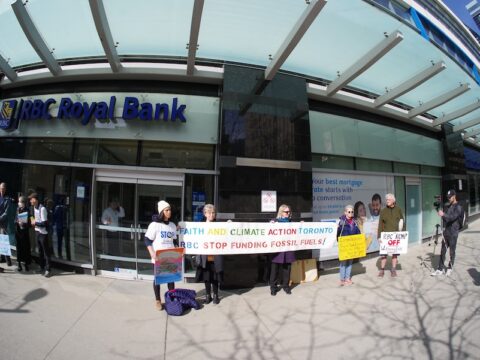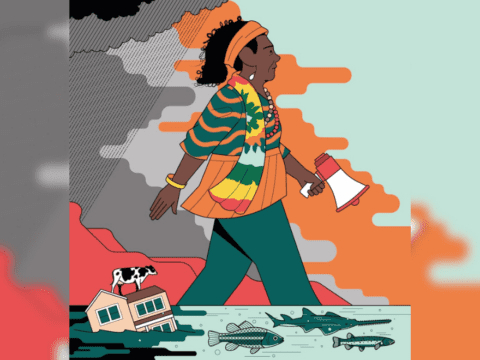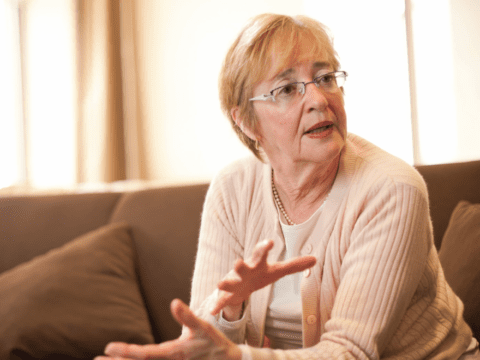Surrounded by leaning stacks of paper related to the proposed Enbridge Northern Gateway pipeline, Russell Ross Jr. says he doesn’t think the $6-billion project will ever be built. The Haisla First Nation councillor isn’t blowing bravado either; he’s offering a considered assessment — the same assessment I heard from half a dozen Indigenous leaders along the B.C. portion of the planned pipeline route.
From Ross’s office it’s a short walk through Kitamaat Village, B.C. — a Haisla community of 800 — down to the shores of Douglas Channel. From there you can see across the water to what would be the western terminus of the 1,177-kilometre pipeline linking the Alberta bitumen sands to the Pacific. Calgary-based Enbridge wants to build a seaport here where 350 supertankers would dock each year.
The ships, headed mostly for Asia, would need to navigate at least 125 kilometres of channels and passageways to get from the port to open ocean. A parallel pipeline would carry condensate in the opposite direction. This toxic mix of chemicals would be used at the Alberta end to dilute bitumen, which is the consistency of peanut butter, so it could flow down the pipes to Haisla territory.
“We’re at ground zero,” says Ross, explaining that the Haisla face the threat of spills at the proposed terminal, along the proposed tanker route, and in the Kitimat River Valley, one of the high-risk sections of the proposed pipeline.
He emphasizes “proposed,” lest anyone forget that the outcome of the Gateway debate is far from certain.
Already a big issue, Gateway is sure to get much bigger, most importantly because the Haisla and a dozen or so other First Nations — under the banner of the Coastal First Nations and Yinka Dene Alliance — vow to show up in court and in front of bulldozers to stop it.
But as significant as that confrontation could be, Gateway is about more than who will win the battle. It is about the moral direction of the country. The federal government is using Gateway to test drive its vision for Canada, both in terms of Indigenous relations and our response to climate change.
From Kitamaat Village, it’s a 10-minute drive around the end of Douglas Channel to the town of Kitimat and First United Church. The congregation was established shortly after the town itself, which was built from scratch by Alcan in the 1950s, when the company opened a massive aluminum smelter that continues to anchor the local economy. Today, the church draws about 40 regulars from Kitimat’s 8,000 residents.
Ken Maitland, chair of the church Council, explains how the pipeline issue plays locally. “It’s an industrial town,” he says. (Maitland himself worked at the smelter for 37 years, much of it as senior environmental technologist.) Many locals are eager for more industry, so they and their children can stay in an area they love.
People come for the jobs, says Maitland, but stay for the outdoor lifestyle. Fishing is huge — quasi-religious. People care about the wilderness and particularly the waterways.
After the initial construction boom, the Enbridge proposal would offer 165 long-term jobs in the area, while posing dramatic risks to waterways. No one knows exactly how many townsfolk oppose the project, but Rev. Larry Scott, minister at First United, says it’s safer to speak against it than for it. The church will hold an in-house discussion of the pipeline issue this month. “The goal is to give people a safe space to share their views,” says Scott, “rather than produce a position statement.”
While the congregation has not taken a public stand, higher courts of the United Church have. In response to a motion initiated by the British Columbia Native Ministries Council, the national General Council passed a resolution in August categorically rejecting Gateway.
The crux of Enbridge’s case for the pipeline is that access to diversified energy markets are “clearly in the national interest,” to the tune of $270 billion in national GDP growth over 30 years. It says pipelines are the safest way to transport crude, that large ships have used Douglas Channel for decades (though not ships of the size proposed for the project) and that the tanker route is well within standard guidelines for marine transport. The company promises extensive precautions, including world-class, state-of-the-art everything and tugboat escorts for tankers transiting the channel.
But Maitland recalls the BC Ferries vessel Queen of the North, which hit an island near the mouth of Douglas Channel in 2006. Despite modern equipment and the fact the ship had travelled the route regularly for decades, human error sank it. This “real-life example” of what can go wrong hovers in the local consciousness, he says.
Maitland is also concerned about regulatory culture. While Enbridge may make commitments up front, he expects that if they operate without incident for several years, they may convince regulators to gradually loosen costly safety measures. He’s seen this pattern play out. “It’s what industry does.” Enbridge’s much-publicized record of spills and bungled responses adds to his concern.
He’s also keenly aware that if there are problems, neither corporate nor political decision-makers will have to take ongoing personal responsibility. In his experience, if something goes wrong, industries “pay a few bucks, they walk away, and the people living in the affected areas suffer the consequences.”
Here, Maitland’s even-keel manner breaks. The fact that the individuals making decisions don’t have to live with the potential fallout clearly bothers him.
To some extent, the safety of the project would boil down to the trustworthiness of Enbridge. Unfortunately for the company, the harder it tries to win over people along the Gateway corridor, the more it seems to fuel doubt.
Several weeks after the media gobbled up a U.S. government report that practically mocked Enbridge for its failed response to a 2010 spill in the Kalamazoo River in Michigan, the company sent eight staff to northern B.C. to hold community information sessions about safety and emergency preparedness. Predictably, Russell Ross was unimpressed by the Kitimat tour stop. He didn’t feel the Enbridge representatives were genuinely interested in hearing from local residents.
The Haisla face greater risks than anyone, he notes. For them, the connection to the waterways is immediate, real and deep. Many people eat salmon and other wild foods regularly. These foods are essential to their ceremonies and their identity. They are “like a birthright,” Ross says. Haisla culture and identity depend on a viable marine environment.
A full-bore rupture of the pipeline in the Kitimat River Valley or a tanker wreck in Douglas Channel could devastate marine life over a large area for a long time. In bad weather, for which the area is notorious, emergency response could be paralyzed.
In addition to bitumen, Ross worries about a condensate accident at the terminal, something his stack of papers says could result in a toxic cloud hovering over the water. What if such a cloud drifted undetected across Douglas Channel to his community in the night? He says he can’t get images of Bhopal, India — where thousands died in their sleep after a gas leak from a factory — out of his mind.
Some would say that comparison is a stretch, but as a leader of a community located at ground zero, Ross would be negligent not to consider worst-case scenarios. When I ask him how he would feel about bitumen-laden tankers venturing deep into Haisla territory, he pauses, as if it’s too hard to even consider.
“I’d have to move away,” he says, his eyes brimming with emotion.
While Ross says the community is unanimous in its opposition to Gateway, the Haisla are not against development itself. Historically, the Haisla were very active in the logging industry. Now, they are willing and savvy players in the potential development of liquefied natural gas (LNG) terminals near the proposed Enbridge port site. (A key difference is that LNG flashes off as a gas if spilled, unlike bitumen, which sits on the water or, worse, sinks.)
Haisla elder Gerald Amos is blunt about what is at stake in the pipeline debate: “our lifestyle as we know it.” Amos is a former Haisla elected chief and a sort of statesman-at-large when it comes to environmental issues in the region. For him, stopping Gateway is about protecting his grandchildren’s right to be Haisla.
Amos summarizes the particular problem with the Enbridge proposal in terms of the “pace, scale and type” of development. It just “doesn’t fit.”
He also says, like every Aboriginal leader I spoke with, that there is nothing Enbridge can do — and certainly no amount of money it can dangle — to make the project acceptable to him.
Enbridge says 60 percent of the roughly 50 First Nations along the proposed route have signed on to purchase a combined 10 percent equity stake in the project. However, this does not change the possibility that the fate of the Northern Gateway proposal may be decided, not by the federal cabinet, as Prime Minister Harper announced it would, but by several small Aboriginal communities. If the government approves the project, “it’s definitely going to the courts,” says Ross. He and other leaders also speak openly about civil disobedience.
Given their resolve and their legal standing — these nations have never ceded or surrendered title to their lands — and given the sheer moral cost to the federal government of overriding the will of so many First Nations, and potentially arresting large numbers of respected Aboriginal leaders, Ross’s dim assessment of the project’s future warrants consideration.
With confrontation seemingly imminent, the tendency is for the public to merely pick sides. On a broader level, though, the issue should cause us to think more deeply about what kind of country we want. In an age of supposed reconciliation with Aboriginal peoples, do we want First Nations to be continually forced to fight for their rights? Do we want them pitted against the greater economic good?
And in an age of global warming, as humanity faces one of its greatest challenges ever, do we want our country to offer the world creative leadership toward a new energy future or just shiploads of diluted bitumen?
***
This story first appeared in The United Church Observer’s November 2012 issue with the title “Gateway ground zero.”















